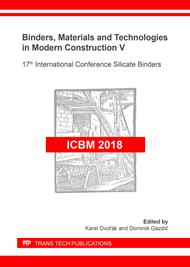p.93
p.99
p.105
p.112
p.118
p.125
p.131
p.137
p.143
The Effect of Fibers on the Basic Physical-Mechanical Properties of the Alkali-Activated Systems
Abstract:
Fiber concrete is a specific kind of concrete which is enriched by suitable type of fibers during its manufacturing process. Due to this fact, better physical and mechanical properties are achieved according to the requirements. To achieve the best quality of the concrete it is necessary to choose the most suitable type of fibers and determine their exact dosage. Alkali-activated systems have been significantly developed in recent years. These are composites that could at least partly replace the Portland cement based materials in the future. This paper deals with the determination of the influence of the type of fibers used on the basic physical-mechanical properties of prepared mixtures and their comparison with the reference mixture. In particular, two types of activators of sodium water glass and anhydrous disodium silicate were used as activator in the experiment. In the experiment, a blast furnace slag was used as a binder. Flexural and compressive strengths were tested and the bulk density, deflection and dynamic modulus of elasticity were determined.
Info:
Periodical:
Pages:
118-124
Citation:
Online since:
August 2019
Authors:
Keywords:
Price:
Сopyright:
© 2019 Trans Tech Publications Ltd. All Rights Reserved
Share:
Citation:


